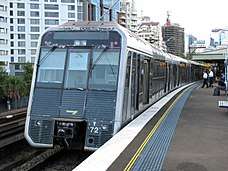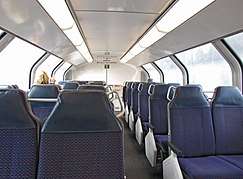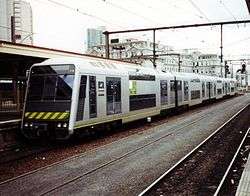Sydney Trains T set
| Tangara | |
|---|---|
 T54 in Sydney Trains livery | |
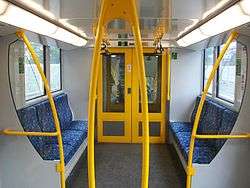 Refurbished Tangara vestibule | |
| In service | 1988-present |
| Manufacturer | Goninan |
| Built at | Broadmeadow |
| Constructed | 1987–1995 |
| Entered service | 1988 |
| Refurbishment |
2003, 2010, 2014 (2018 planned) |
| Number built | 455 carriages |
| Number in service | 447 carriages |
| Number scrapped | 8 |
| Formation | 4 car sets |
| Capacity | 98 in driving trailers, 112 in motor cars |
| Operator(s) | Sydney Trains |
| Depot(s) |
Hornsby Maintenance Depot Mortdale Maintenance Depot |
| Line(s) served |
T1 North Shore, Northern & Western Line T4 Eastern Suburbs & Illawarra Line South Coast Line to Port Kembla |
| Specifications | |
| Car length | 20.320 m (66 ft 8 in) |
| Width | 3 m (9 ft 10 in) |
| Height | 4.413 m (14 ft 6 in) |
| Weight | 42 tonnes (41 long tons; 46 short tons) |
| Traction system |
8 x 170 kW (230hp) 4-quadrant GTO Chopper Control (Mitsubishi Electric) |
| Track gauge | 1,435 mm (4 ft 8 1⁄2 in) |
The Tangara (an Aboriginal Australian word meaning to go) is a class of electric multiple unit operated by Sydney Trains in Sydney, Australia. The Tangaras were delivered between 1988 and 1995, and are third-generation trains.[1]
Design
A Tangara is a double-deck four-car set, with the two outer cars being driving control trailers fitted with one pantograph each and the middle two cars being non-control motor cars. They are equipped with air conditioning and chopper control.
Two subclasses of Tangara were built, the suburban sets targeted as T sets, and outer-suburban sets originally targeted as G sets. The T sets replaced the first generation of Sydney's electric rolling stock.[1] The G sets were converted to suburban use and were re-targeted as additional T sets.
Unlike most other Sydney Trains rolling stock the seats on the suburban T sets are fixed, meaning that half the seats face backwards.
The G sets differed from the T sets in originally having round green door buttons, high-backed reversible seats, toilets, fresh water dispensers and luggage racks. Some of these features were removed when the G sets were converted to suburban operation. Additionally, the G sets were delivered with a revised design at the front and rear of the train, most notably the pinstriped grey panels below the cab windows were replaced with light orange panels for improved visibility.
Set G7 was fitted with an AC drive system for evaluation purposes with the existing DC stock and compatibility with signalling and communication systems on the network. G7 was scrapped in 2005 at Maintrain, Auburn after the Waterfall train disaster, as all four cars were beyond repair.
Delivery
In July 1986 the Government of New South Wales awarded A Goninan & Co a contract for 450 carriages.[2] In 1993 it was decided that the last 80 carriages of the order would be built to a modified design to operate peak-hour services on services to Wyong, Port Kembla and Dapto.[3] In 1996 five spare driving trailers were ordered.[4]
The first train was unveiled at Sydney Central in December 1987,[5] entering service in April 1988. The final T set was delivered in February 1994 and the final G set in October 1995.[6]
The cars built were:
- T set driving trailer cars: D6101-D6284 with additional spare cars D6285-D6289
- T set non-driving motor cars: N5101-N5284 with additional spare car N5285
- G set driving trailer cars: OD6801-OD6840 with additional spare car OD6841
- G set non-driving motor cars: ON5801-ON5820
- G set non-driving motor cars with toilet: ONL5851-ONL5870
In service
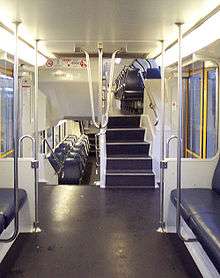
When first introduced, the T sets were fitted with passenger door release handles to prevent loss of air conditioning at stations. These were later disconnected (and later removed) due to passengers not getting used to opening the doors for themselves when needed. The seats originally had fabric upholstery, but this was gradually replaced by blue vinyl.
In the early 2000s, all Tangaras were updated with a new CityRail corporate appearance. This involved painting the passenger doors and much of the front and rear ends of the trains yellow. Blue and yellow stripes along the bottom of the carriages were replaced by a single yellow stripe and updated CityRail logos were placed on the driving cars.
Conversion of G sets to T sets
In late 2005, 15 V set carriages were suddenly withdrawn due to the discovery of corrosion in their underframes. G sets began to operate more off-peak Intercity services to Port Kembla, Kiama, and Wyong to cover for the withdrawn V sets. H sets started entering service in December 2006. The newer trains feature a very similar level of passenger amenity to the G sets and can be seen as a continuation of the design. Their introduction lead to a change in the role of the G sets. From 2007 the G sets were progressively redeployed to suburban services, providing extra capacity on high-demand existing services such as on the Western line and allowing new services to be introduced. By 2008 G sets were often used on peak suburban services that extend into intercity areas, such as services to Springwood (via the Western line).
In 2009, the conversion of G sets to T sets began, to improve their suitability for suburban working as H sets took over their outer suburban duties. Conversion work consisted of the removal of toilets and their replacement with additional seating. Other work included the installation of new handrails and hangers and the recoding of cars and sets. G4 was the first to be converted (into T104). In 2010 sets being converted started receiving a full interior refurbishment as part of the program to refurbish all the Tangara carriages.
Upgrades in the 2010s
In 2010 a refresh of the Tangaras commenced with the interiors repainted, and new seating upholstery and handrails fitted.[7][8]
In July 2013, Sydney Trains trialled rearranging the seating on the upper and lower decks of two carriages. There were 16 fewer seats per carriage; 3x2 seats were replaced by 2x2 seats in one carriage while in the other carriage there are double seats on one side and a bench style seating on the other. The carriages were later returned to normal.[9]
In 2014, phase one of a technology upgrade program, aiming to improve reliability and upgrade ageing components, was underway.[10] A contract for phase two of the program, aiming to extend the life of these trains and bring technology into line with newer trains was awarded to UGL Limited in August 2015. This was expected to be completed by July 2018.[11][12] The expected completion date has been revised to 2019.[13]
The program includes overhauling air conditioning units and windscreen wiper units, and replacing passenger side doors, train operating systems and driver's desks.[10]
Damaged carriages
The following Tangara carriages have been scrapped due to accidents:
- Driving Trailer Cars: D6114, D6127, D6274, OD6831 & OD6832
- Motor Cars: N5127, ON5816 & ONL5866
The following are replacement carriages:
- D6285 & N5285 are replacing written-off cars D6127 & N5127
- D6286 is on set T99 (replacing written-off D6274)
- D6287 is on set T73 (replacing written-off D6114)
- D6108 is on set T16 (replacing D6241 for unknown reasons)
- D6288 is on set T71 (replacing D6108 which is replacing D6241)
- D6289 is on set T24 (replacing D6148 which is replacing D6106)
- D6184 is on set T37 (repaired set back to normal)
- D6841 is on ex Outer Suburban Tangara set T121 (replacing D6807 for unknown reasons; D6807 is stabled at Auburn Maintenance Centre)
Driving trailer car D6127 and motor car N5127 were both involved in the Wentworthville train derailment on 27 December 1989, the first major accident involving the Tangara fleet. D6127 was written off, having collided with the platform. N5127 was sent to Dunheved on the Ropes Creek line for training fire fighters, along with S Set car C3866.[14]
Lines serviced
The Tangaras usually operate on the following lines. Since 2013 their operation on Sector 2 has ended timetable services with all of them being displaced to Sector 1 since A sets do not operate on that sector.
Tangaras operates on the following line:
- T4 Eastern Suburbs & Illawarra Line: Bondi Junction to Waterfall & Cronulla
- T1 North Shore, Northern & Western Line: Emu Plains or Richmond to City Via Parramatta, City To Berowra or Hornsby via Gordon and City to Hornsby via Strathfield
- South Coast Line: Waterfall & Thirroul to Port Kembla
Occasionally, as required, they will operate on other suburban lines, as all drivers are trained for Tangaras.
4D
A train bearing strong resemblance to a Tangara, known as the 4D, was built by A Goninan & Co in 1991 for the Public Transport Corporation.[15] Although outwardly similar to the Tangaras it was mechanically very different being built to be compatible with the Comeng trains operated in Melbourne. It was included in the sale of Hillside Trains to Connex Melbourne in August 1999. It wasn't successful and after spending large periods out of service, being withdrawn in December 2002 and stored at Newport Workshops. The 4D was bought by CityRail for parts before being scrapped in March 2006 at Sims Metal, Brooklyn.
References
- 1 2 The four generations of electric rolling stock CityRail
- ↑ "Tangara Contract" Railway Digest September 1986 page 273
- ↑ "A Goninan & Co" Railway Digest October 1993 page 417
- ↑ "A Review of Electric Multiple Unit rolling stock" Railway Digest September 1996 page 32
- ↑ "Tangra Preview" Railway Digest February 1988 page 49
- ↑ "450th Tangara Delivered" Railway Digest December 1995 page 6
- ↑ Major makeover for Tangara fleet NSW Government 30 April 2010
- ↑ Tangara fleet to get make-over CityRail Xpress edition 127 28 April 2010
- ↑ "All change as RailCorp is disbanded" Sydney Morning Herald 1 July 2013
- 1 2 "Transport for NSW 2013-14 Annual Report" (PDF). Transport for NSW. p. 28. Retrieved 13 February 2018.
- ↑ UGL awarded $131m contract for Tangara technology upgrade UGL Limited 5 August 2015
- ↑ Newcastle train builder awarded $131m contract ABC News 5 August 2015
- ↑ "Fleet update - September 2017" (PDF). Transport for NSW. September 2017. p. 4. Retrieved 12 February 2018.
- ↑ "A Review of Electric Multiple Unit Rolling Stock" Railway Digest September 1994 page 32
- ↑ Double Deck Development and Demonstration (4D) Train Vicsig
Further reading
- Beckhaus, John; Halgren, Stephen (2007), Sydney's Electric Trains, Australian Railway Historical Society NSW Division, ISBN 978-0-9757870-8-3
External links
![]()
- T set technical diagrams Transport for NSW
- G set technical diagrams
